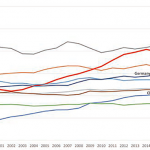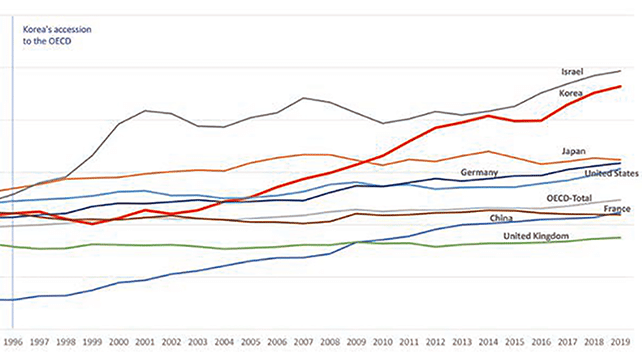AI and GenAI in LegalTech

South Korea’s Technology Protection Strategy of National Core Technologies
December 25, 2023
Trial Prep Considerations
April 5, 2024
The concept of infusing Artificial Intelligence into legal technology solutions started at the onset of the digital age, around the time when smartphones became widely available and AI began to be practically applied to optimize user experiences based on prior user behavior. Brands that rushed to develop and incorporate AI into their products and services included global flagship companies such as Amazon (Alexa), Apple (Siri), and subscription-based organizations, Netflix and Spotify, that began to feature the ability to provide AI-based recommendations to users.
In this blog, we will focus on AI development in LegalTech and begin with a brief overview on TAR, CAL, and GenAI, followed by an in-depth view of GenAI and LLMs (Large-Language Models). We will then turn our attention to the potential applications of this burgeoning technology, and close by touching upon the current state of acceptance as it pertains to GenAI-based solutions across the legal services landscape.
TAR, Predictive Coding and CAL
In the legal services industry, AI was first meaningfully referenced as Technology Assisted Review (“TAR”), which leveraged the use of computer algorithms to help identify relevant documents within a data set. These machine-learning algorithms analyze prior document tagging decisions made by human reviewers in conjunction with document content to identify similar documents likely to receive the same document coding. This capability gave rise to the notion that trained algorithms can justifiably expedite the identification of relevant documents, thereby leading to the widely accepted and interchangeable use of the terms “predictive coding” and “TAR”.
Such initial machine learning algorithms, new to legal technology solutions, continued to improve and evolve, soon giving way to a new algorithm that significantly reduced the initial human review component and became widely referred as Continuous Active Learning or “CAL”.
TAR and CAL
The fundamental difference between TAR and CAL is the underlying machine-learning algorithm used to predict which documents are relevant to a case. The choice of algorithm affects how human reviewers will train the system, how resilient the algorithm is against incorrect human tagging, and the practical considerations needed to achieve the best results for your review. As the use of CAL gained popularity over the past 5 to 7 years, it soon became referred to as “TAR 2.0” in the legal community, thereby rendering the initial iteration of predictive coding – which is still widely used today and recognized by courts – as “TAR 1.0”.
How Different Is GenAI Compared to Prior AI in LegalTech?
Generative AI represents a significant leap in Artificial Intelligence development and is drastically different from most previous forms of machine learning, not only in the legal industry but across every industry or aspect of human life. The critical difference between GenAI and previous AI iterations is the capacity to generate completely new content.
Unlike previous models and algorithms, which were powerful in their own right and could quickly interpret, sort and classify data, Generative AI is capable of interacting with human users in a question-and-answer format to produce complete, coherent answers to natural language queries. In this manner, unlike the chat bots of yore, GenAI does not rely on preprogrammed responses, and can easily pull context for answers from various sources available to the system or provide opinions on data outside of the system’s training scope.
Naturally, these differences have given birth to a wide variety of potential applications of Generative AI, such as the ability to generate contract language, create case summaries, or help legal professionals quickly access laws and regulations, all of which were previously unattainable with older natural language learning models.
LLMs - Their Role in Powering GenAI & How They Differ from Existing Algorithms
Generative AI and LLMs (Large-Language Models) tend to quite often be used interchangeably, but it is important to recognize that while these are related concepts, they are not the same thing. Generative AI is a general catch-all term to describe AI systems capable of generating new content, whether it involves audio, video, written text or something else. LLMs, on the other hand, are machine learning models that focus primarily on interpreting, analyzing and composing text-based data. In other words, all LLMs are a form of generative AI, but not all generative AI relies on LLMs. Since the legal field is heavily text-driven, most of the time LLMs will be the only form of generative AI e-discovery practitioners are exposed to, although as the variety of data sources used in data collections expands, it is possible that generative AI driven by other types of media will come to the fore as well. For the purposes of this blog, we will cover only LLMs and text-based aspects of Generative-AI and disregard other types of Generative AI that deal with image or movie generation.
With that out of the way, there are a few key differences between LLMs and previously used models such as LSI and SVM, which are the two technologies that underpinned TAR 1.0 and TAR 2.0 (“CAL”).
The most important difference is the ability to generate new output. Both LSI and SVM models were designed to be simple and effective approaches to classify, label or cluster document sets of varying size using a limited amount of sample documents as training material. Their primary focus is to effectively analyze the characteristics of the data they are provided, and not attempt to interpret the language present in the data in any meaningful way. Instead, these models apply a statistical approach (LSI) or a hyperplane method (SVM) to solve a specific problem (document classification) using pre-coded seeds (data) analyzed by the models.
Conversely, LLMs are trained on an incomparably greater volume of documents, and to a much greater depth, which allows LLMs to understand the context and syntax behind human language in a way that enables the creation of new content that can also mimic the writing style used in a specific industry.
A general overview of the differences in practice are provided below for quick reference:
TAR 1.0
- Requires a training phase to reach an optimal point of reviewed documents determined with support from a Data Scientist or TAR expert.
- Not all documents categorized or scored by the algorithm will have been seen by a human.
- Additional training phases may be required to account for new data, guidance or other activities learned throughout the review.
CAL/TAR 2.0
- Requires a brief training phase to kickstart the review.
- Algorithm continuously learns from human coding decisions and prioritizes human review of documents most likely to be relevant to the matter.
- Review continues until all documents identified by the algorithm as relevant have been checked by a human reviewer.
LLM
- Model is pre-trained on massive data sets.
- Capable of identifying relevant documents before any human-coded examples are introduced into the system.
- Multiple use cases beyond classifying data into buckets.
Breadth & Scope of GenAI Usage Driven by LLM Networks
The increased ability of Generative AI models does present certain challenges. For example, LLMs are computationally intensive, and may require significant IT resources to train with additional data. They also typically require a large amount of data for training and will suffer if trained on insufficiently large data sets – this is one of the instances in which an older model, like LSI or SVM, may be more appropriate to use.
Last but not least, most pre-existing LLMs are trained on general language text and may encounter some degradation in performance if required to evaluate text laden with industry-specific jargon that is absent from the initial training data. This point underscores the importance of noting that this technology is still in its nascency. Nevertheless, the drawbacks of exploring the use of LLMs are currently limited, and those that exist are likely to be resolved with future technological improvements. This combined with the upside of discovering a wide range of new opportunities to leverage AI in LegalTech renders a promising future for the creation of innovative solutions.
Potential Applications of GenAI
Let’s take a look at some examples of new ways in which LLMs can be used to help lawyers with daily activities:
- Legal Document Generation
There have been recent attention-grabbing headlines with lawyers opting to use ChatGPT, or similar LLMs, to generate court briefs and filings, that unfortunately failed miserably. Their motivation is understandable as generating briefs and filings is often a rote task ripe for automation, which would afford lawyers with more time to focus on more complex tasks, if not simply amplify their current case load. In-house counsel may similarly look to LLMs to help automate corporate contract creation or verification.
On the surface, these types of tasks should be well suited for the current iteration of Generative AI – most briefs, filings and contracts re-use existing content from previously generated work product – and if any additional creativity is required it can always be added after the AI has generated its base product.
The notable failings that have been subject to much criticism from the legal community and judges come from the so-called “algorithmic serendipity”. This is the ability of Generative AI to “hallucinate” and produce results that do not actually exist. This kind of creativity, while laudable in some fields, creates issues in a field that relies on true verifiable precedent, such as law. Alarmingly, some studies have found that when it comes to issues of law, LLMs hallucinate in as much as 70% of the cases, most of the time creating citations to non-existing cases or citing non-existing regulations.
This does not mean LLMs cannot be used for the purpose of generating legal documents. They can, and can be reasonably expected to significantly simplify and streamline the process, but LLMs should not be used without verifying every source and citation.
- Q&A Chat Bots
One of the most impressive aspects of LLMs is, unsurprisingly, their ability to generate interactions that feel natural and conversational as opposed to scripted. LLMs are able to interpret natural language queries very effectively, often providing a direct response to the query along with supporting context, while in some cases correcting typos and flagging unspoken assumptions in the original query.
This functionality can be used to great effect to familiarize employees with company regulations by looking up provisions from Code of Conduct or other applicable internal rulebooks, and can also assist with legal document drafting by referencing provisions from applicable state and federal regulations.
As a preventative measure, using LLMs to support internal chat bots can help educate employees on relevant regulations to mitigate potential misbehavior, and if subject to government investigations, may demonstrate to government officials that the company was not negligent with taking available measures to inform employees on relevant legal requirements. Although this aspect of AI usage can also be subject to hallucinations, as described in the previous segment, hallucinations should occur less frequently if used to support chat bots since this training would be based on smaller documents sets, which would be more narrowly tailored to the task at hand. Furthermore, this training can be expanded through reinforcement learning, which is a process whereby answers are validated against existing material to ensure their accuracy.
- Generate Rapid Insights for Investigative Purposes
The ability of LLMs to generate content allows them to go one step further than previous AI models, which were already frequently used in investigative contexts to provide on-the-fly document summaries, identify facts related to custodians, and construct fact-based timelines. Considering that LLMs are pre-trained and can be deployed on document sets right away, thereby foregoing traditional model training, AI can significantly expedite fact-finding tasks by enabling investigators to dig into a case immediately after deploying the LLM. Given that time can be of utmost importance with investigations, the time-savings alone make the use of LLMs worth considering over traditional approaches.
- TAR X.0 / LLMs – Review Prioritization and Classification
So far, a lot of attention has been paid to leveraging the generative capabilities of LLMs, but what about a more traditional approach when the model is required to enhance the document review process by prioritizing data based on relevance? Or by identifying a document review cut-off point, at which most relevant content has already been reviewed? Should eDiscovery practitioners still rely on older models like LSI or SVM, or should they consider migrating completely to using LLMs? The answer here is not very straightforward. There are pros and cons to all models and LLMs are no different.
We have already discussed several benefits of using LLMs, and another notable addition would be LLMs ability to provide multiple label classification. In other words, step away from the binary classification of TAR 1.0 and TAR 2.0 (relevant or not relevant), and classify data based on multiple tags simultaneously. This can be particularly helpful when it comes to issue tags and issues classification. In some cases, the pre-trained nature of LLMs can also allow one to completely forgo initial model calibration and identify likely relevant material before any review takes place, saving valuable time.
An example workflow might involve asking your LLM via a prompt to identify documents relevant to a particular question or subject (which can correspond directly to items from the RFP – although some prompt engineering might be necessary) and having LLM suggest the documents that might be responsive to that prompt. This can go one step further and have the same model identify the segment within each document that directly relates to the query fed into the model, and it can be done for multiple prompts at the same time. The reviewers can then focus on those suggestions to prioritize their initial review process, and add additional prompts or use other methods to pull in additional documents as necessary.
That said, non-LLM models still have their place in your toolkit especially when it comes to review of highly specialized data that may not overlap with LLMs trained on general language data, or for instances in which non-LLM models are trained and calibrated specifically for a particular type of data. In such cases, it is likely that non-LLM models will produce higher levels of precision than LLM equivalents.
Additionally, when it comes to audit requirements, the complexity of an LLM’s architecture may present some difficulty with substantiating why a particular document was labeled a certain way. In this manner, older models can provide more transparency into its AI decision making than current LLM models.
Last but not least, many of the available LLMs have a token limit in terms of how many characters per document they would consider in their analysis. If a document happens to exceed the token limit (and long documents are, unfortunately, an all-too-frequent sight in the legal field) – quality of AI analysis might deteriorate.
Conclusion
There are very few industries that will remain directly unaffected by GenAI, and fewer yet that will not benefit in some way from this technology. Today, the magnitude of expected disruption can be felt all around us with conference halls buzzing about AI seminars, stock markets pushing shares of companies upwards of 300%, such as NVIDIA, a primary provider of AI-enabling chips, and courts beginning to respond to the use of GenAI in LegalTech.
Electronic discovery is certain to receive a positive impact from the use of Generative AI as well. As the past decade has shown, other automation technologies have become permanent fixtures in many discovery workflows, and GenAI is now primed to augment and/or add to existing processes due to user-friendly and intuitive interfaces that many solutions provide.
At this time, however, there remain certain challenges with using LLMs in the legal field, and AI hallucinations is at the top of the list. It is our belief that most of these issues will be overcome through the use of reinforcement learning and overall general improvement of LLMs over time. Therefore, it is possible that classification workflows (most leverage some form of CAL) will be supplanted by LLM-driven workflows similar to how CAL replaced TAR 1.0 for many users. However, it is important to note that TAR 1.0 is recognized by courts worldwide and commonly used by legal teams. At FRONTEO, for example, our proprietary KIBIT AI engine continues to power technology assisted solutions across all business lines, and although we continue to innovate and evolve KIBIT with cutting edge technology, we anticipate GenAI-based solutions will most likely serve as an additional option for legal teams over the next few years, as opposed to outright replacements for existing, proven solutions ingrained within workflows that are used with great effect.
The massive and rapid changes to the way we execute and deliver legal services will surely make for a bumpy road, but as long as certain precautions are taken, GenAI will significantly improve the practice of law. However, it is important to keep in mind that GenAI is not a miracle solution for every problem and should be viewed as “a” tool, but not “the” tool, and consequently, be treated with the same amount of diligence and care as any other application or technology in your software stack.
Sources:
-
Hallucinating Law: Legal Mistakes with Large Language Models are Pervasive
https://hai.stanford.edu/news/hallucinating-law-legal-mistakes-large-language-models-are-pervasive -
Artificial Intelligence for Lawyers Explained
https://pro.bloomberglaw.com/insights/technology/ai-in-legal-practice-explained/#genAI -
TAR vs CAL – A Primer
https://www.iltanet.org/blogs/rachel-mcadams1/2021/04/21/tar-vs-cal-a-primer#:~:text=So%20both%20TAR%20and%20CAL,are%20relevant%20to%20the%20case -
A (Very) Long Discussion of Legal Document Summarization Using LLMs
https://www.linkedin.com/pulse/very-long-discussion-legal-document-summarization-using-leonard-park
リーガル業界で既に活用されているテクノロジーアシストレビュー(TAR)や継続的能動学習(CAL)と呼ばれる、”教師データ”が必要な機械学習アルゴリズムを持つ従来型のAIと比較し、昨今注目を集めているのが生成AIのモデルのひとつであるLLM(大規模言語モデル)です。LLMは法的文書作成や社内規定や州・連邦規制条項等を検索できるQ&Aチャットボット、また文書の要約や調査作業の迅速化、複数タグに基づくデータ細分類化による関連資料のレビュー前特定など、応用の可能性が大きく期待されています。
しかしLLMを含む生成AIは、ハルシネーション(事実に基づかない情報を生成すること)などの課題があることから、現時点での活用にはまだ注意が必要です。




